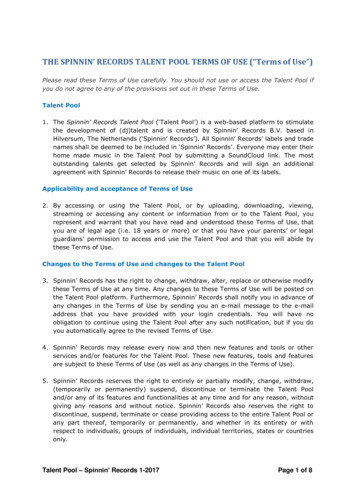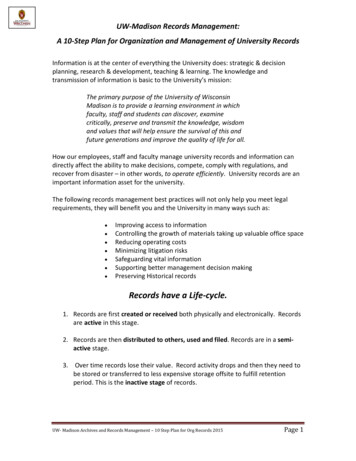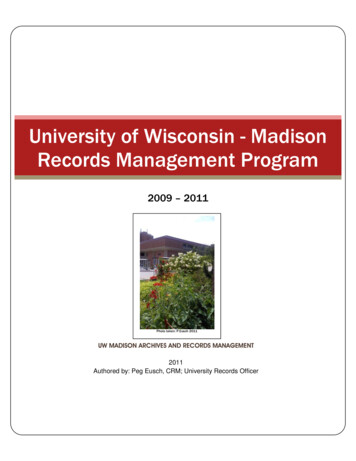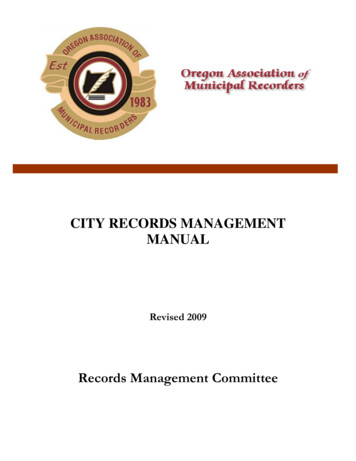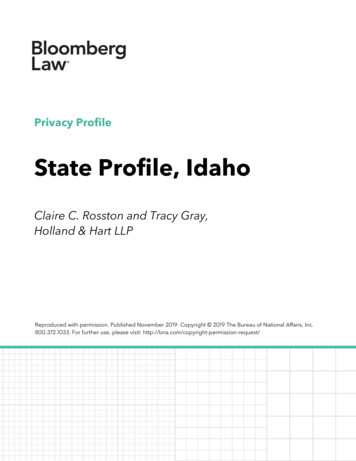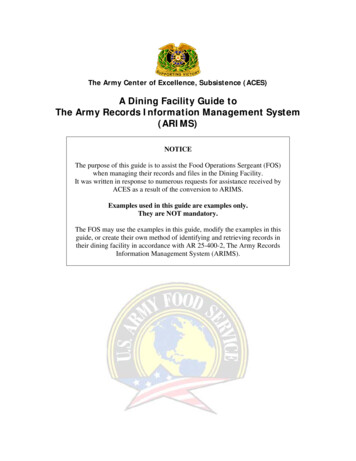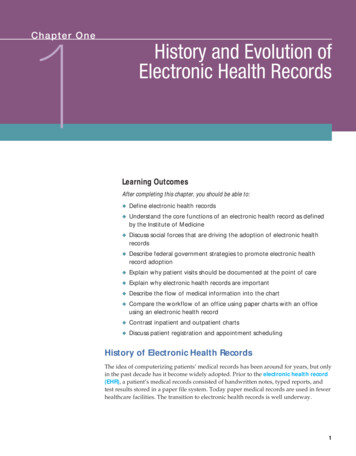
Transcription
Guide to the Records of the Department of Egyptian,Classical, and Ancient Near Eastern Art1890s–2002Search the Libraries and Archives ONLINE CATALOGThe Museum Libraries and Archives are open to the public by appointment only. If youwish to visit, please click here for more information or e–mail the Library atlibrary@brooklynmuseum.orgBrooklyn Museum200 Eastern ParkwayBrooklyn, NY 11238www.brooklynmuseum.org
ContentsProject staff .3Acknowledgments .4Department namesand Curatorial staff .5Departmental history .7Curator biographies .14Administrative note .17Scope and content .18Series descriptions .19Departmental administration .19Excavations .19Exhibitions .19General correspondence .20Dealers .21Institutions.21Objects .22Publications .22Research .22Extra-museum activities .23Audio-visual materials .23Folder descriptions .24Departmental administration .24Excavations .28Exhibitions .30General correspondence .39Dealers .49Institutions.53Objects .62Publications .66Research .69Extra-museum activities .70Audio-visual materials .71Guide to the Records of the Department of Egyptian, Classical, and Ancient Near Eastern Art2
Project staffProject DirectorDeirdre LawrencePrincipal Librarian &Coordinator of Research ServicesProject ManagerDeborah WytheArchivist & Manager ofSpecial Library CollectionsProject ArchivistLaura PeimerProject AssistantEd McLoughlinGuide to the Records of the Department of Egyptian, Classical, and Ancient Near Eastern Art3
AcknowledgmentsWe are extremely grateful to the Andrew W. Mellon Foundation for recognizing thevalue and importance of the Brooklyn Museum’s archives to the scholarly community. Inparticular, we wish to thank Angelica Rudenstine for helping us develop a plan to makethese archival collections available for research. The Mellon-funded Museum ArchivesInitiative grant to the Brooklyn Museum has supported the staff in its efforts to arrange,describe, and preserve the records of the Department of Egyptian, Classical, andAncient Near Eastern Art.The Guide to the Records of the Department of Egyptian, Classical, and Ancient NearEastern Art is the culmination of the efforts of many individuals at the Brooklyn Museum:Deirdre Lawrence oversaw the project; Deborah Wythe supervised and managed thetechnological aspects; and Laura Peimer and Ed McLoughlin processed and describedthe collection.As a product of the Andrew W. Mellon–funded Museum Archives Initiative, this guidewill be made available online, along with several other finding aids, to provide greateraccess to the collections held in the Brooklyn Museum Libraries and Archives. We hopethese tools will benefit researchers for many generations to come.Guide to the Records of the Department of Egyptian, Classical, and Ancient Near Eastern Art4
Department namesDepartment of AntiquitiesDepartment of Egyptian and Classical ArtDepartment of Ancient ArtEgyptian DivisionClassical DivisionDepartment of Ancient ArtEgyptian SectionGreek and Roman SectionDepartment of Ancient ArtDepartment of Egyptian and Classical ArtDepartment of Egyptian, Classical, andAncient Middle Eastern ArtDepartment of Egyptian, Classical, andAncient Near Eastern 102010–presentCuratorial staffEdwin L. M. TaggartAssistantAssistant Curator of Egyptology1930–19321932–1936Jean Capart (1877–1947)Honorary Curator of EgyptologyAdvisory Curator of EgyptologyHonorary Advisory Curator of Egyptology19321933–19371938–1940John Ducey Cooney (1905–1982)Assistant Registrar/RegistrarAssistant CuratorCurator of Egyptology(military leave 1942–46)Curator of Egyptian ArtKeeper of the Charles Edwin Wilbour CollectionActing 631947–19631959–1963Elizabeth Riefstahl (1889–1986)Librarian, Wilbour Library of Egyptology1937–1956Assistant Curator1945–1956Associate Curator Emeritus of the Wilbour Collection 1956–1975Bernard V. Bothmer (1912–1993)Assistant Curator1956–1958Associate Curator1958–1963Curator1963–1967(Leave of absence for research and Fulbright fellowship, 1963)Guide to the Records of the Department of Egyptian, Classical, and Ancient Near Eastern Art5
Vice Director of CollectionsChairman and Keeper of the Wilbour Collection1968–19761977–1982Donald P. HansenConsultant1963Richard A. Fazzini (1942–)Cataloger of Ancient Egyptian objectsAssistant CuratorAssociate CuratorCuratorCurator-in-ChargeChairmanCurator 831983–19891989–20062006–presentJean Lewis Keith (1930–)Curatorial AssistantAssistant CuratorResearch Associate1964–19661966–19691969–1970Biri Fay (1947–)Junior AssistantCuratorial AssistantAssistant Curator1969–19701970–19741974–1976Robert S. Bianchi (1943–)Curatorial AssistantAssociate CuratorCurator19761979–19891989–1992James F. Romano (1947–2003)Assistant CuratorAssociate a R. Russmann (Ann)Honorary Research AssociateAssociate CuratorCuratorCurator sentEdward Bleiberg (1951–)Associate CuratorManaging Curator1998–20062006–presentYekaterina BarbashAssistant Curator2008–presentGuide to the Records of the Department of Egyptian, Classical, and Ancient Near Eastern Art6
Departmental historyBeginning in 1898, a year after the Brooklyn Institute of Arts and Sciences opened itscentral building, the Museum began actively collecting Egyptological and classicalobjects, either through private donations or sponsored excavations. Prior to 1932, whenthe Department of Antiquities 1 was created, the Museum acquired Egyptian andclassical objects through the efforts and guidance of William H. Goodyear, the firstcurator of the Department of Fine Arts. By the mid-1930s, the newly establishedcuratorial department was also funneling resources into scholarly publications,exhibitions and installations, preservation, and special projects.Goodyear acquired the first Egyptian objects for the Museum through a donation byAmelia B. Edwards in 1898 and worked steadily to enhance the collection. In 1904 herecounted:. . . in the past year the Museum has also made a beginning in thedirection of Greco-Roman and Egyptian antiquities, and in the latterfield it is now favored with the help of Dr. Wm. Flinders Petrie in thechoice of purchases. . . . In Greek and italic pottery the Museumhas 23 pieces, well distributed as regards types and periods for thegiven number. The ancient terra cottas number 10; the bronzevessels, 5; iron tools, 6, and other metals (hinges and an ironchain), 11. 2French Egyptologist Henri de Morgan was an important contributor of artifacts in theseearly years. De Morgan organized two expeditions (1906 and 1908) of the predynasticcemeteries of Upper Egypt (Esneh district), donating prehistoric objects from theseexcavations to the Museum in 1909. De Morgan was an important early figure in thefield of Egyptology. Through his system of dating and identifying the sequence ofobjects, he divided prehistoric Egyptian culture into two distinct types with differentcustoms. Goodyear greatly valued de Morgan’s theory and decided that “this divisionwill be illustrated in the installation and labeling of the exhibits from his excavations.”3Henri de Morgan’s brother Jacques, who was also an Egyptologist, donated a gift of acataloged selection of duplicates from his excavations at Susa in 1908. That same year,the Museum purchased an Egyptian collection that included bronzes, amulets, and amummy coffin from Armand de Potter.The Museum also acquired objects directly through archaeological excavations,developing an important relationship with the British-based Egypt Exploration Fund,later known as the Egypt Exploration Society. In return for financial support, theMuseum received a share of the objects excavated by the Fund. This arrangement1Precursor to the current Department of Egyptian, Classical, and Ancient Near Eastern Art.Goodyear, William H. “Report on the Department of Fine Arts.” Museums of the Brooklyn Institute of Artsand Sciences: Report for the Year 1904 (Brooklyn, NY: The Museum, 1905), 16-7.3Goodyear, William H. “Report on the Department of Fine Arts.” Museums of the Brooklyn Institute of Artsand Sciences: Report for the Year 1908 (Brooklyn, NY: The Museum, 1909), 21.2Guide to the Records of the Department of Egyptian, Classical, and Ancient Near Eastern Art7
would continue throughout the century and be a critical source of objects for theMuseum collection.By 1909, Goodyear had begun installing the objects acquired from de Potter, deMorgan, and the Egypt Exploration Fund. He was occupied with installing and labelingthe Egyptian collections for many years. He once wrote about the objects: “coming, asthey do, from many different sources, and having been acquired at many different datessince 1901, when the Egypt Exploration Fund made its first donation to the Museum,this task has been one of exacting character.”4Other donors helped to augment the collection. Robert B. Woodward donated a groupof rare Egyptian polychromatic specimens and A. Augustus Healy donated twenty-oneTanagra figurines to supplement the Greek pottery collection. In 1914, on behalf of theMuseum, Professor T. Whittemore of the Egypt Exploration Fund excavated Egyptianantiquities at Sawama, near the city of Akhmim. Whittemore also brought back rareanimal mummies from the ibis cemetery at Abydos. In 1915, the Museum purchased183 pieces of Byzantine-period Coptic Egyptian textiles.In 1916, the heirs of Charlotte Wilbour, who had been married to the noted EgyptologistCharles Edwin Wilbour, donated objects from Wilbour’s collection and his Egyptologicallibrary. A year later this donation was augmented by a collection of Egyptian goldjewelry and other objects from Charlotte and Charles Edwin’s daughter TheodoraWilbour. In 1921, the family also donated a group of Egyptian antiquities, mainlyamulets. The generosity of the Wilbour family had a profound impact on the Museum in1932, when the bequest of Victor Wilbour, the only son of Charles and Charlotte,established the Charles Edwin Wilbour Fund to enlarge the Egyptian collections. TheWilbour Fund was crucial to the future of Egyptology at the Museum, establishing boththe Wilbour Library of Egyptology, which contained Wilbour’s extensive Egyptologicalbooks, and a curatorial department for ancient Egyptian art, which was then called theDepartment of Antiquities.The Museum hired Egyptian archaeologist Jean Capart as Honorary Curator ofEgyptology. Capart began cataloging and reinstalling the Egyptian collection, while alsorecommending purchases from dealers and collectors throughout the world. Under hisguidance, the gallery space for Egyptian objects was reorganized and officiallyreopened on May 19, 1933, as The Charles Edwin Wilbour Memorial Hall. He arrangedthe objects to show the full chronology of ancient Egyptian history and culture, fromprehistoric times until the conquest of Egypt by the Roman Empire. The collection in1933 was, as described by then-director William Henry Fox:. . . particularly rich in the objects of the 18th Dynasty and theperiod of Tell-el-Amarna and King Akhenaten, and it is felt that theMuseum can be of the most benefit to the community if wespecialize, more or less, in this period and make no attempt to4Goodyear, William H. “Report on the Department of Fine Arts.” Museums of the Brooklyn Institute of Artsand Sciences: Report for the Year 1913 (Brooklyn, NY: The Museum, 1914), 18.Guide to the Records of the Department of Egyptian, Classical, and Ancient Near Eastern Art8
compete with the other larger collections that have already hadmany years building-up in other museums of the city. It is throughthis period that the present day can obtain the clearest view of theancient Egyptians. 5There began a flurry of inspired activity in the department. The curators started to directresources into publishing scholarly works, such as series, monographs, and articles.Along with Claire Preaux of the Egyptological Foundation of Queen Elisabeth, Brussels,Capart surveyed and cataloged the Greek ostraka. A loan exhibition belonging to Mrs.John Morris, Ancient Glass Beads & Related Objects, opened in December 1933.Assistant Curator Edwin L. M. Taggart wrote the Short Guide to the Charles EdwinWilbour Collection. New acquisitions included a “walking lion” of the Saitic period, avotive-pectoral of Ptolemy V, and a sketch of Queen Nefertiti on a limestone flake.In 1934, work continued on the reinstallation of objects and the cataloging of the entirecollection. A special installation of photographs of Egypt and archaeological sitescoincided with the official opening of the Wilbour Library. The Egypt Exploration Societycontributed objects to the Museum and Capart also purchased objects during trips toEgypt, including a recumbent lion in granite dating to late Egyptian times. He alsoobtained an elaborately decorated coffin that contained a mummy.The Museum created a new classical division within the department in order to provideproper care for a small but steadily growing collection of objects of ancient Greek andRoman origin, including a quantity of bronzes, ceramics, glass, jewelry, and terracottasacquired through purchases and loans. On November 23, 1934, a Classical Court (nowknown as the Beaux-Arts Court) located within the third-floor central rotunda officiallyopened to display these objects. The objects were organized in a way that did not “traceartistic evolution; rather, the aim was to give a sense of the daily life of the times.”Objects were displayed in cases illustrating ceremonial rites, warfare, medicine,household activities, industry, and other cultural themes. Large hand-lettered andillustrated labels linked objects with their sociological and historical background. 6 In thedivision of classical art, Taggart and his staff recataloged and accessioned objects.With new resources and a developing collection, Capart began to initiate larger projects,including the installation of an entire room of sculptured limestone from the Tomb ofThary in 1935. That same year, the department worked extensively on labels,combining specialized object labels with more general thematic labels. Capart andTaggart also conceived of a “scientific” project that involved measuring and classifyingthe collection of prehistoric Egyptian skulls by type in order to discover the origins of theEgyptian people. 7 The exhibition Chalice of Antioch and Accompanying Antioch5Fox, William H. “Report of the Director.” Museums of the Brooklyn Institute of Arts and Sciences: Reportfor the Year 1933 (Brooklyn, NY: The Museum, 1934), 11.6Williams, Phyllis. “Curatorial Reports: Ancient Art - Classical Division.” Museums of the BrooklynInstitute of Arts and Sciences: Report for the Year 1934 (Brooklyn, NY: The Museum, 1935), 13.7Capart, Jean. “Ancient Art: Division of Egyptian Art.” Museums of the Brooklyn Institute of Arts andSciences: Report for the Year 1935 (Brooklyn, NY: The Museum, 1936), 32.Guide to the Records of the Department of Egyptian, Classical, and Ancient Near Eastern Art9
Treasure opened in December 1935. It was the first time that this early collection ofChristian art had been publicly exhibited on the East Coast of North America.During John D. Cooney’s first year as curator in 1936, the department renovatedstorage space to house the collection adequately. It also published the Wilbour Diary, arecord of the activities and discoveries of Charles Edwin Wilbour. The same year, theNew-York Historical Society lent the Museum its collections of Egyptian and Assyrianantiquities, realizing that the Brooklyn Museum was better equipped to house anddisplay them. Installed separately in the Wilbour Hall, the Society’s objects greatlyenhanced the Brooklyn Museum’s collection.As curator, Cooney traveled to Egypt and the Near East, visiting monuments andexcavations and making a survey of various sites that were under Egyptian rule duringthe 18th Dynasty. He also contributed resources from the Charles Wilbour Fund to theEgypt Exploration Society’s excavations at Amara in Nubia.Important acquisitions at this time included a variety of Coptic sculpture and textiles,which were featured in Paganism and Christianity in Egypt (1942), the first exhibition ofCoptic art in the United States. The purchase of a bronze incense burner, a stonecarving of a panther’s head, and a tunic enhanced this exhibition. The departmentpublished a number of studies in the early 1940s, including the first volume of TheWilbour Papyrus, which concerned a papyrus dating from the reign of Ramesses V thathad been purchased by the Museum in 1935.During World War II, John Cooney served in the U.S. Army as an intelligence officer inLondon. While overseas he scoured the dealers and collectors for objects and acquirednew works for the Museum, such as a copper figurine of a mother and child dating fromthe early Middle Kingdom and a glass vase of lapis lazuli blue from the 18th Dynasty.He also acquired books for the Wilbour Library, which were regularly shipped toBrooklyn. During the war years, Elizabeth Riefstahl assumed the titular duties of curator,while continuing to serve as librarian of the Wilbour Library.In 1948 the New-York Historical Society’s collections of Egyptian and Assyrianantiquities, which the Brooklyn Museum had housed since the 1930s, were permanentlyacquired and incorporated into the Charles Edwin Wilbour collection. The curatorsreevaluated the gallery space and installation in consideration of the absorption of thesociety’s collection, deciding to reserve the Wilbour Gallery for the finest objects andearmark the large gallery in the west wing for study collections.Also during the late 1940s, staff began to evaluate objects and initiate extensiveconservation projects that would continue for many years. This work began in 1948 withthe examination of a large bequest from Theodora Wilbour—a group of ten intact andsealed Aramaic papyri from the Jewish colony at Aswan. Professor Emil Kraelingprepared the first publication regarding these papyri in the 1950s. The tedious task ofassembling their scattered fragments continued throughout the 1950s and early 1960s.Guide to the Records of the Department of Egyptian, Classical, and Ancient Near Eastern Art10
In the 1950s, the department continued to develop the collection. It allocated resourcesfor excavations, exhibitions, scholarly publications, and installations, the latter of whichbegan to emphasize art history rather than ancient history, religion, or archaeology. Inthe early part of the decade, the Museum contributed Wilbour funds to excavations,including an expedition in Sudan at Soba, a Christian site south of Khartoum. Museumtrustees also allocated funds for an expedition to Tangasi, an area in Sudan associatedwith the Late Meroitic or early Christian era. In 1953, a new installation of the renovatedEgyptian galleries received critical acclaim.The department acquired several important objects during the 1950s, such as an OldKingdom wooden sculpture and a 25th Dynasty black granite block statue from thecollector Charles Pratt. Other acquisitions included a number of reliefs from theMetropolitan Museum of Art (several came from the tomb of Nespakashuty’ and wererestored and installed in 1986) and, in 1956, a limestone doorjamb, the mate to one thathad been donated by William Flinders Petrie fifty years earlier. Purchases at this timeincluded a Third Dynasty relief of the royal official Akhty-hotep from North Saqqara, aMiddle Kingdom statue mounted on a limestone base, and several New Kingdomobjects, such as a life-size limestone torso of Akhenaten found in the excavations atAmarna in 1891. In 1958, the department reinstalled the Coptic and classicalcollections, which had been in storage. Curators also prepared the Museum’s west wingfor the installation of the Ramesside and Late Period collections, which opened in 1959.Bernard Bothmer joined the staff of the department in 1956. One of his early curatorialaccomplishments included the organization of the exhibition Egyptian Sculpture of theLate Period (1960), featuring objects from institutions in Egypt, Europe, Canada, andthe United States. This exhibition marked the the first time in its history that the CairoMuseum lent Egyptian objects to an institution in the United States. It was also the firsttime that the Louvre Museum allowed Egyptian objects to leave France. As MuseumDirector John Cooney later wrote: “This generous cooperation resulted in an exhibitionof such distinction that it was one of the most successful ever held in the Museum.”8The department purchased an important group of ten late Dynasty 18 limestone reliefsin 1960. Two years later the reinstallation of the east galleries began, which includedrecently accessioned objects from Dynasties 12 through 18 and a few additional casesin the Old Kingdom section. The galleries reopened in 1963.In 1962 there were impressive additions to the department’s holdings of classical art.Mary Olcott bequeathed an important collection of Greek vases to the Museum inmemory of her brother and grandfather. The Museum also purchased a limestonesculpture of the head of the god Helios. During the summer of 1963 the Museum’scollection of Hellenistic and Roman bronzes, which were part of the Harriman bequestof 1921, were studied, cleaned, and cataloged.8Cooney, John D. “Department of Ancient Art.” The Brooklyn Museum Annual II, III, 1960–1962(Brooklyn, NY: The Museum, 1963), 67.Guide to the Records of the Department of Egyptian, Classical, and Ancient Near Eastern Art11
Following a leave of absence for a Fulbright fellowship in 1963, curator BernardBothmer served as Project Director on an expedition to Mendes, located halfwaybetween Cairo and the Mediterranean at Damietta. Bothmer initiated this project inorder to train American students in modern stratigraphic field methods in Egypt and tolearn more about the archaeology of the Nile Delta of Lower Egypt. This excavationcontinued through the 1980s with funding from a group of supporters known as the“Friends of Mendes.” Beginning in 1966, the department received federal grants for anumber of overseas archaeological projects, including the construction of scale modelsof Egyptian monuments and sites, the study of ancient Egyptian goldwork, and aphotographic survey of ancient sites in the Nile Valley.In 1969, with funding from the Kevorkian Foundation, the Brooklyn Museum establishedthe Department of Middle Eastern Art and Archaeology under the curatorship of CharlesK. Wilkinson. Museum director Thomas Buechner announced the creation of the newdepartment in the Museum’s annual report, noting that it would “contain the Ancient andIslamic Middle East collections, now the responsibility of the Departments of Ancient Artand Oriental Art.” 9At the same time, the Department of Egyptian and Classical Art continued to flourishunder the curatorship of Bernard Bothmer. In 1970, Thomas Buechner acknowledgedBothmer’s work by noting:I must confess great professional pride in one area in which I hadno effect: the galleries of ancient art. Bernard Bothmer’s beautifulinstallations continue, as they did before I came, to be among theMuseum’s most impressive. Always well maintained and constantlyenriched with new acquisitions, they were further improved thisyear with the addition of a refurbished funerary gallery. 10The 1972 exhibition Akhenaten and Nefertiti: Art from the Age of the Sun King featuredan impressive catalog prepared by Cyril Aldred, Keeper of Art and Archaeology at theRoyal Scottish Museum. Also in 1972, Elizabeth Riefstahl edited a publication onobjects in the collection called Miscellanea Wilbouriana, named in honor of CharlesEdwin Wilbour. Department staff also advised and assisted in the installation of thenewly built Luxor Museum in Egypt.In the late 1970s, the department focused on the reinstallation of several galleries,including one dedicated to Aegean, Greek, Roman, and Coptic art and another onedisplaying Egyptian art of the Ramesside and Third Intermediate Periods. In 1976, theMuseum began participating in an archaeological project at Thebes, which became anexcavation of the Precinct of the Goddess Mut at Karnak, the site of the main statetemples in southern Egypt.9Buechner, Thomas S. “Report of the Director.” The Brooklyn Museum Annual, Vol. X, 1968–9 (Brooklyn,NY: The Museum, 1969) 15-6.10Buechner, Thomas S. “Report of the Director.” The Brooklyn Museum Annual Vol. XII, 1970–1(Brooklyn, NY, The Museum, 1972), 14.Guide to the Records of the Department of Egyptian, Classical, and Ancient Near Eastern Art12
In 1978, the department organized the monumental exhibition Africa in Antiquity: TheArts of Ancient Nubia and the Sudan. Africa in Antiquity was the first international showof ancient art from Africa south of Egypt. Twenty-five institutions in the United States,Europe, and Africa lent more than 250 objects, covering the history of Nubia and theSudan from 3000 B.C. to the twelfth century A.D.Charles Wilkinson, who had been curator of the Department of Middle Eastern Art andArchaeology since 1969, was succeeded by Irma Fraad in October 1974. Fraad wasfollowed by Madeline Noveck in 1976. Noveck left in 1979, at which point thedepartment was dissolved and the collections dispersed to other departments. Islamicobjects were absorbed into the Department of Oriental Art, while Egyptian and classicalobjects became part of the Department of Egyptian and Classical Art. The departmentwas renamed the Department of Egyptian, Classical, and Ancient Middle Eastern Art(ECAMEA) in 1982.In the early 1980s, additions to ECAMEA’s holdings included an Egyptian stela fromDynasty 18, a Ramesside sarcophagus, an early Iranian painted pottery vessel, and aNabatean bust of a goddess. A small gallery was created for temporary exhibitions,beginning with Wilbour in Egypt (1983), which commemorated the sesquicentennial ofthe birth of Charles Edwin Wilbour. In 1985 the curators began work on Cleopatra’sEgypt, a major exhibition on Ptolemaic Egypt that opened three years later. It was thefirst major international loan exhibition to concentrate on the art of the Ptolemaic Periodand included 166 objects from 43 lenders throughout America and Europe. Anotherdepartment project in the 1980s included the refurbishment of the Hagop KevorkianGallery of Ancient Middle Eastern Art.The department produced many publications at this time, including Ancient Greek andRoman Gold Jewelry in The Brooklyn Museum (Wilbour Monograph VIII, 1984) byPatricia Davidson and Andrew Oliver, Jr., and Predynastic and Archaic Egypt in TheBrooklyn Museum (Wilbour Monograph IX, 1984) by Winifred Needler. In the spring of1989 the Museum published Ancient Egyptian Art in The Brooklyn Museum by RichardFazzini, Robert Bianchi, James Romano, and Donald Spanel, which includeddescriptions and essays on one hundred of the department’s finest objects.In recent years, the department has dedicated more resources to preserving objectsalready in the collection, to “resurrecting
Precursor to the current Department of Egyptian, Classical, and Ancient Near Eastern Art. 2. Goodyear, William H. "Report on the Department of Fine Arts." Museums of the Brooklyn Institute of Arts and Sciences: Report for the Year 1904 (Brooklyn, NY: The Museum, 1905), 16-7. 3. Goodyear, William H. "Report on the Department of Fine Arts."



